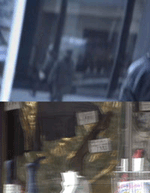Symphony Diagonal: A Film by Solange Fabião
We stand for an hour and three minutes in the dark in front of a large screen on which the familiarity of the city had evaporated into tiny fragments, slivers of city life wedged into a darting camera. A small box, the camera itself, is handheld in a large yellow box, a New York taxi, which moves from northwest to southeast on the only trace of an aboriginal Manhattan. This trace lends movement along this axis as one of the most distantly reverberating sounds. We can barely fathom the sequence of events, or make the necessary connection between that which is revealed in the course of this short epic voyage. Any episodic tendency is rigorously denied and we are propelled again, forever again in the direction of the moving taxi while the camera performs a short movement of delay, pointing slightly back. This delineates a rapid zigzag, seen above the horizontal, which ceaselessly pursues its diagonal track. It makes the simple passage into a complex plot with its moments of reversal, recognition, and suffering. Something like poetic meter is established through the parallel movements of car and camera. The visual depth of the continuous shot is interrupted by a different vista, the crossroads with a distant view, as remote at times as the Hudson River and the New Jersey shore. Rhythms are formed as the camera is threaded through the tissue of the city.
The young visitor to Rome in Jean-Marie Straub’s film History Lesson does just that when he first arrives in Munich. He is seated in a compact convertible with the roof open: the camera takes in the rough and tumble of the narrow streets of Rome. Endless shots are interspersed with staged interviews with ancient Roman characters. In the work of Solange Fabião the handheld camera is her shield. You remain transfixed, petrified before the curly snakes of the pulsating city unless you see the city reflected darkly through the lens. Our attempts, these shots, arched crested waves beating on the shore of the island. Solange Fabião thrusts her lance forward as she points her camera as if to pierce the city’s chest. Her sequential yet aleatory encounters, along with her precise choreography make everything still, living, and on the move, her endless movement back and forth implies recovered vividness, the indefatigable din of this town, this city has been struck by Solange Fabião’s zigzag intervention. Michael Snow has given us the back and forth and the central region but he never turned his gaze so close, he has never occupied himself with the city.
Ever since Leon Battista Alberti we have had to confront an infinite field of possibility, when conceiving of the relation of the interior to the exterior, or vice versa. The relation itself becomes apparent in the reassuring sense that art is indeed all that exists inside the frame. The bars of rectilinear primary colors are nothing but diagonal forces that move across the surface of the canvas. Compared with the theoreticians of neoplasticism to an architectural plane, they provide a frame without being a limit. They incessantly reappear at the margin of our field of vision or alternatively as the fragment of a vast, infinite space that we are hardly capable of inhabiting except as a thing of the mind.
The frame through which we are invited to see, hear, and contemplate Broadway is a traveling diagonal, a derive that cuts through the grid of Manhattan. This is a camera in defiance, a camera that rebels against the close grain epic of a city refusing to line itself up or down. With Solange Fabião’s camera we penetrate the island, we cross through, she puts us on the path of this place, with a certain step, crossing the threshold. We are put on a path of an impossible passage, indeed the non-passage that exist only in the mind, the event of watching, which no longer has the form of the movement that consists in passing, traversing, or transiting. It is the event that has no longer the form or the appearance of the original step she made, when she boarded the taxi armed with the camera. Her pace, her rhythm, this zigzagged passage, we can take it as an invitation to a certain experience of hospitality, as the crossing of the threshold by an observer who is free, or not, to come.
She appears to block our path, more precisely, with this rite of passage, the path as a barred path is no longer what it is. It is the memory of that which carries the future. We are invited to experience this diagonal from both sides of an indivisible line according to her thinking, her gift.
New York, April 2000
Yehuda E. Safran
